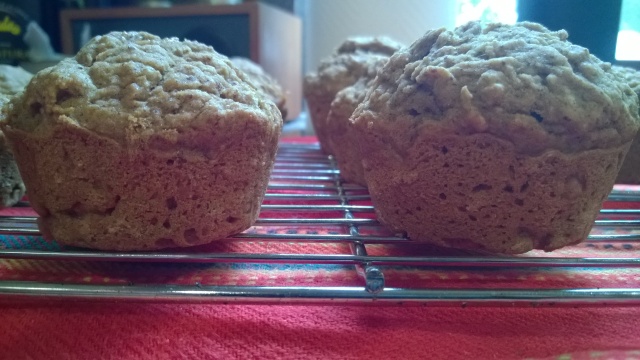This is one of those things that’s so easy to make yourself that you’ll wonder why you never did it before. It’s basically the exact same thing as making an herbal tincture although you don’t need to pack it so tightly with the vanilla beans, and you might want to let it cure a bit longer than the average tincture.
All you need are a few vanilla beans which you can buy in grocery store bulk bins, online, or packaged in jars or bags like above in a spice aisle, alcohol such as vodka, rum, bourbon, or brandy, a jar and time.
![DCEA082A-E46D-496F-98C4-5262E4E169DF[1]](https://i0.wp.com/botanicalalchemyandapothecary.com/wp-content/uploads/2018/09/DCEA082A-E46D-496F-98C4-5262E4E169DF1.jpg?resize=819%2C1024&ssl=1)
I chose vodka because I want to use this extract in my DIY natural perfumes as well as in baking, and vodka has the most neutral scent. I’ll definitely be using the extract in the waffles that I make all the time, and these zucchini muffins too, so it’ll be versatile and well used with the vodka. As with all things herbal, there are plenty of variations with which to experiment, but basically you want at least 4 vanilla beans per cup of alcohol. First split the vanilla beans down the middle lengthwise with a sharp knife.
![450565AC-B97F-4AE1-939D-F629A494535B[1]](https://i0.wp.com/botanicalalchemyandapothecary.com/wp-content/uploads/2018/09/450565AC-B97F-4AE1-939D-F629A494535B1.jpg?resize=828.75%2C829&ssl=1)
It’s hard to tell, but the bean closest to the knife has a long slice down the middle. Next, put the beans in a clean glass jar, then pour the alcohol over them, making sure they are completely submerged.
![56D9408A-1DB7-4432-BD75-98728090FE94[1]](https://i0.wp.com/botanicalalchemyandapothecary.com/wp-content/uploads/2018/09/56D9408A-1DB7-4432-BD75-98728090FE941.jpg?resize=819%2C1024&ssl=1)
Cap the jar or bottle tightly, then shake it daily (or at least every other day after the first week) for at least four weeks.
At this point the vanilla extract can be used, but you will probably still smell the alcohol, so it depends on whether you are baking with it or using it in a non-heated recipe like frosting if you taste just vanilla or the alcohol as well. (The heat in baking and cooking will get rid of the alcohol taste/scent.) After two to three months, the vanilla extract should smell only of pure, rich vanilla. That means, if you want to make holiday gifts of homemade vanilla extract, you will want to get this started by early October. (Yup, already thinking along those lines!) Also, the more beans you originally put into the mixture, the more vanilla-y it will be, so keep that in mind. You want at least four per cup, but you can definitely add more than that. Vanilla beans are the second most expensive spice, after saffron, due to the delicate harvesting and curing of the beans, so sticking with four per cup is perfectly fine.
You don’t have to ever take the beans out actually, though if you are giving some of yours as a gift, taking out the old beans and adding a fresh one to the container looks lovely and continues to add depth and richness to the extract. (You don’t even need to cut it down the middle at that point.) Vanilla extract lasts indefinitely if stored in a lidded container in a relatively cool, dark place.
Enjoy, and if you love making your own herbal concoctions, check out my latest course on the Art and Craft of Herbalism. Take care and enjoy the transition to cooler days, crisper nights, and crunchier walks. Please subscribe for weekly posts about herbs, natural health, and green beauty, and please share this with anyone who might be interested.


![DB220EBF-5447-4FB9-9A6A-FAAF74404F1A[1] Prepackaged](https://i0.wp.com/botanicalalchemyandapothecary.com/wp-content/uploads/2018/09/DB220EBF-5447-4FB9-9A6A-FAAF74404F1A1.jpg?w=456&h=456&crop=1&ssl=1)
![08023EDB-20E0-4701-AD8E-AFD85886F1F4[1] Day 1](https://i0.wp.com/botanicalalchemyandapothecary.com/wp-content/uploads/2018/09/08023EDB-20E0-4701-AD8E-AFD85886F1F41.jpg?w=410&h=513&ssl=1)
![EF7CA258-5135-4E2D-AC0A-392902D95D90[1] Day 1 with label](https://i0.wp.com/botanicalalchemyandapothecary.com/wp-content/uploads/2018/09/EF7CA258-5135-4E2D-AC0A-392902D95D901.jpg?w=410&h=513&ssl=1)
![DE06B0A8-5229-435A-A5D5-398069A90B04[1] Four weeks](https://i0.wp.com/botanicalalchemyandapothecary.com/wp-content/uploads/2018/09/DE06B0A8-5229-435A-A5D5-398069A90B041.jpg?w=824&h=825&ssl=1)

![F8F114EC-3821-4B1C-B3BA-28D6734E4E12[1]](https://i0.wp.com/botanicalalchemyandapothecary.com/wp-content/uploads/2018/08/F8F114EC-3821-4B1C-B3BA-28D6734E4E121.jpg?resize=828.75%2C833&ssl=1)
![48BC3942-2879-42F6-B9F6-66273D4709D2[1] 48BC3942-2879-42F6-B9F6-66273D4709D2[1]](https://i0.wp.com/botanicalalchemyandapothecary.com/wp-content/uploads/2018/08/48BC3942-2879-42F6-B9F6-66273D4709D21.jpg?w=410&h=410&crop=1&ssl=1)
![2C876D82-CB0E-4B83-8191-F0A06005D1A1[1] 2C876D82-CB0E-4B83-8191-F0A06005D1A1[1]](https://i0.wp.com/botanicalalchemyandapothecary.com/wp-content/uploads/2018/08/2C876D82-CB0E-4B83-8191-F0A06005D1A11.jpg?w=410&h=410&crop=1&ssl=1)
![9FE53C8F-171D-4B58-812E-68D55A51E6F4[1]](https://i0.wp.com/botanicalalchemyandapothecary.com/wp-content/uploads/2018/08/9FE53C8F-171D-4B58-812E-68D55A51E6F41.jpg?resize=828.75%2C829&ssl=1)
![98349DF0-652C-4BD5-9C55-97A2593031E2[1]](https://i0.wp.com/botanicalalchemyandapothecary.com/wp-content/uploads/2018/08/98349DF0-652C-4BD5-9C55-97A2593031E21.jpg?resize=300%2C300&ssl=1)
![0D8D70D7-383A-4DB5-A577-19727E390EED[1]](https://i0.wp.com/botanicalalchemyandapothecary.com/wp-content/uploads/2018/08/0D8D70D7-383A-4DB5-A577-19727E390EED1.jpg?resize=828.75%2C829&ssl=1)





![0B2D021F-1459-4D57-9833-E43DB0EF0CA4[1]](https://i0.wp.com/botanicalalchemyandapothecary.com/wp-content/uploads/2018/06/0B2D021F-1459-4D57-9833-E43DB0EF0CA41.jpg?resize=828.75%2C671&ssl=1)
![D705522A-63B2-4CE6-9315-6EC26EA822D0[1]](https://i0.wp.com/botanicalalchemyandapothecary.com/wp-content/uploads/2018/06/D705522A-63B2-4CE6-9315-6EC26EA822D01.jpg?resize=828.75%2C654&ssl=1)



![71BF7D5F-E702-47DF-BAF7-E420E2EE07C8[1] 71BF7D5F-E702-47DF-BAF7-E420E2EE07C8[1]](https://i0.wp.com/botanicalalchemyandapothecary.com/wp-content/uploads/2018/03/71BF7D5F-E702-47DF-BAF7-E420E2EE07C81.jpg?w=417&h=418&ssl=1)
![111B96D2-33C6-4237-84D2-3C92F483CF67[1] 111B96D2-33C6-4237-84D2-3C92F483CF67[1]](https://i0.wp.com/botanicalalchemyandapothecary.com/wp-content/uploads/2018/03/111B96D2-33C6-4237-84D2-3C92F483CF671.jpg?w=403&h=418&ssl=1)
![1CC8D5B1-443D-472F-90ED-CB46BEA96694[1]](https://i0.wp.com/botanicalalchemyandapothecary.com/wp-content/uploads/2018/03/1CC8D5B1-443D-472F-90ED-CB46BEA966941.jpg?resize=828.75%2C829&ssl=1)






![F50B9E08-6402-4FB6-A366-8771FF230DA6[1]](https://i0.wp.com/botanicalalchemyandapothecary.com/wp-content/uploads/2018/03/F50B9E08-6402-4FB6-A366-8771FF230DA61.jpg?resize=828.75%2C623&ssl=1)
![788A2839-DECA-4DCA-8BF1-3618837C3C9A[1] 788A2839-DECA-4DCA-8BF1-3618837C3C9A[1]](https://i0.wp.com/botanicalalchemyandapothecary.com/wp-content/uploads/2018/03/788A2839-DECA-4DCA-8BF1-3618837C3C9A1.jpg?w=410&h=410&crop=1&ssl=1)
![4513E383-DDAB-4E3E-AFCD-1CD18274BA57[1] 4513E383-DDAB-4E3E-AFCD-1CD18274BA57[1]](https://i0.wp.com/botanicalalchemyandapothecary.com/wp-content/uploads/2018/03/4513E383-DDAB-4E3E-AFCD-1CD18274BA571.jpg?w=410&h=410&crop=1&ssl=1)

![873EEE91-8D10-46B6-BC28-195E2087D2D5[1]](https://i0.wp.com/botanicalalchemyandapothecary.com/wp-content/uploads/2018/03/873EEE91-8D10-46B6-BC28-195E2087D2D51.jpg?resize=240%2C300&ssl=1)
![B9E879BB-BC76-4629-A996-20C6FBC5357E[1]](https://i0.wp.com/botanicalalchemyandapothecary.com/wp-content/uploads/2018/03/B9E879BB-BC76-4629-A996-20C6FBC5357E1.jpg?resize=828.75%2C829&ssl=1)
![60CC06EA-3A85-42CD-B760-E6E47C36BC39[1]](https://i0.wp.com/botanicalalchemyandapothecary.com/wp-content/uploads/2018/03/60CC06EA-3A85-42CD-B760-E6E47C36BC391-1024x1024.jpg?resize=828.75%2C829&ssl=1) Once your ball is a good size, take a large-eyed needle or crochet hook to bury the end of the yarn into the ball. You can completely bury it, or cut off the end of the yarn after a few tucks if you prefer. Here’s Lani showing how it’s done:
Once your ball is a good size, take a large-eyed needle or crochet hook to bury the end of the yarn into the ball. You can completely bury it, or cut off the end of the yarn after a few tucks if you prefer. Here’s Lani showing how it’s done:![WP_20180308_11_45_39_Pro_(2)[1]](https://i0.wp.com/botanicalalchemyandapothecary.com/wp-content/uploads/2018/03/WP_20180308_11_45_39_Pro_21.jpg?resize=828.75%2C568&ssl=1)
![3645E236-F1EC-43CE-A87B-E0E7CC5B3204[1]](https://i0.wp.com/botanicalalchemyandapothecary.com/wp-content/uploads/2018/03/3645E236-F1EC-43CE-A87B-E0E7CC5B32041-300x269.jpg?resize=300%2C269&ssl=1)